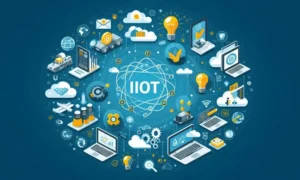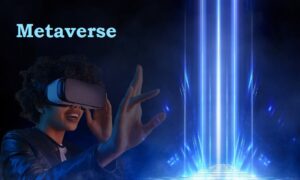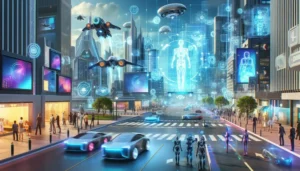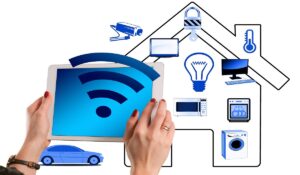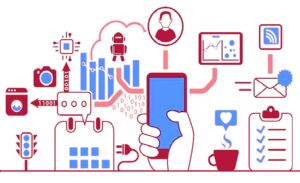How the Internet of Things (IoT) is Disrupting Digital Marketing?
The Internet of Things (IoT) is reshaping how we live, work, and interact by connecting everyday objects to the digital world.
The Internet of Things is disrupting digital marketing as IoT offers exciting opportunities for businesses to enhance their marketing efforts. It transforms marketing tecnics by providing deeper insights, personalized experiences, and creative ways to connect with consumers. As this technology continues to evolve, marketers have an exciting landscape to explore.
In this blog, we will discuss the top 10 benefits of using IoT in digital marketing. Let’s get started!

Internet of Things Uses: Overview
The Internet of Things (IoT) refers to a network of physical devices, vehicles, appliances, and other objects embedded with sensors, software, and network connectivity. These smart devices can collect and share data, creating an interconnected ecosystem. Here are the key points about IoT:
- IoT encompasses a wide range of devices, from simple smart home gadgets (like thermostats) to wearables (such as smartwatches) and complex industrial machinery. These devices communicate with each other and other internet-enabled systems.
- IoT is transforming various sectors, including manufacturing, transportation, healthcare, and agriculture. It enables data-driven decision-making and improved efficiency.
- The integration of IoT into marketing has opened up exciting possibilities for businesses to engage with consumers in innovative ways.
- IoT enables real-time communication with consumers. For instance, a smart refrigerator could notify you when you’re out of milk and suggest nearby deals. Brands can engage customers at various touchpoints, from personalized offers to post-purchase follow-ups.
- IoT-generated data helps optimize marketing strategies. By analyzing patterns and trends, businesses can make informed decisions. Whether it’s adjusting inventory levels or tailoring promotions, IoT enhances efficiency and ROI.
The Intersection of IoT and Digital Marketing
The Internet of Things (IoT) is permeating every aspect of our lives, from smart home devices to QR codes in commercials. In the realm of marketing, IoT offers exciting possibilities.
IoT provides marketers with a wealth of data about consumer behavior. By connecting everyday objects (like smart home appliances) to the internet, marketers gain insights into product usage. This data allows for personalized messaging and more relevant interactions throughout the customer journey.
Let’s find out some examples of how IoT is reshaping digital marketing:
Coinbase’s Super Bowl Ad:
During the 2022 Super Bowl, cryptocurrency exchange platform Coinbase aired a mysterious one-minute ad. It featured a QR code bouncing around a black screen, reminiscent of the old “DVD” logo. When viewers scanned the QR code with their smartphones, they were directed to Coinbase’s website, where they received $15 for signing up and downloading the app. This creative use of QR codes demonstrates how IoT can connect consumers to digital platforms in innovative ways.
Heineken’s “The Closer” Campaign:
Heineken launched a campaign inspired by the work-from-home trend during the pandemic. They introduced “The Closer,” a Bluetooth-connected bottle opener. When users opened a Heineken bottle, the device detected it using an accelerometer, communicated via Bluetooth, and shut down selected work apps on their devices. This campaign encouraged work-life balance and sparked conversations about prioritizing leisure time with loved ones.
Customized Content and Contextual Messages:
IoT allows marketers to collect real-time data from everyday objects. Imagine a refrigerator recognizing when you’re out of milk and suggesting the best deals nearby. Or streetlights adjusting their brightness based on foot traffic. Marketers can leverage this context to deliver highly tailored messages to consumers at the right moment.
Personalization:
The Internet of Things plays a pivotal role in personalizing consumer experiences. In IoT-equipped stores, smart fitting rooms recommend clothing based on a customer’s style preferences and past purchases. Real-time consumer behavior data optimizes store layouts, ensuring personalized and efficient shopping experiences. By leveraging real-time data from IoT devices, personalized experiences can be contextualized based on users’ immediate surroundings and activities.
Enhanced Customer Engagement:
IoT enables deeper interactions with customers throughout their journey. From personalized recommendations based on smart home data to location-based offers delivered via wearable devices, marketers can create seamless and relevant experiences. For instance, a fitness tracker might recommend a nearby health food store after a workout.
Data-Driven Insights:
IoT generates vast amounts of data. Marketers can analyze this data to understand consumer behavior, preferences, and pain points. Whether it’s optimizing supply chains or predicting customer needs, IoT-driven insights empower better decision-making.
Now, Let’s explore the top 10 benefits of using the Internet of Things in digital marketing.

10 Benefits of Using The Internet of Things in Digital Marketing
The Internet of Things (IoT) is revolutionizing digital marketing by connecting everyday objects to computing devices via the internet. Here are ten exciting applications of IoT in the marketing landscape:
Location-Based Marketing:
IoT allows marketers to deliver personalized messages based on a user’s location. For instance, a coffee shop could send a discount coupon to someone passing by. Smart billboards and beacons enhance this approach.
Wearable Devices:
Fitness trackers, smartwatches, and other wearables collect valuable data. Marketers can use this information to tailor content, such as suggesting nearby gyms or health food stores after a workout.
Connected Appliances:
Smart home devices like refrigerators, ovens, and washing machines can communicate with users. A fridge could recommend recipes based on its contents, or an oven could send cooking tips.
QR Code Campaigns:
Brands can use QR codes as gateways to IoT devices. For instance, Coinbase’s Super Bowl ad featured a mesmerizing QR code that led viewers to their website, where they received $15 for signing up and downloading the app.
Smart Packaging:
IoT-enabled packaging can provide real-time information to consumers. Imagine a cereal box that alerts you when it’s running low or a medicine bottle that reminds you to take your pills. These interactions enhance customer engagement and loyalty.
Health and Wellness Apps:
IoT-powered health apps track users’ activity, sleep, and vital signs. Marketers can collaborate with these apps to promote relevant products or services, such as fitness gear or healthy meal delivery.
Interactive Retail Experiences:
Smart mirrors in fitting rooms can suggest complementary clothing items. Augmented reality (AR) apps allow customers to virtually try products before purchasing.
Predictive Maintenance:
In B2B marketing, IoT helps monitor machinery and equipment. Companies can offer predictive maintenance services, ensuring uninterrupted operations for their clients.
Environmental Sensing:
IoT devices collect environmental data, such as air quality or temperature. Marketers can leverage this information for location-specific campaigns or eco-friendly messaging.
Smart Vehicles:
Connected cars provide opportunities for targeted advertising. Imagine receiving restaurant recommendations based on your route or personalized offers from nearby gas stations.
Read Here: How is Internet of Things Used in Digital Marketing?
Conclusion: IoT in Digital Marketing
The Internet of Things (IoT) transforms marketing by enabling personalized experiences, real-time insights, and seamless interactions between consumers and products. The Internet of Things is not just about smart devices; it’s also about connecting the physical and digital worlds. As marketers embrace this technology, they will find new ways to engage consumers, personalize content, and create memorable brand experiences.
